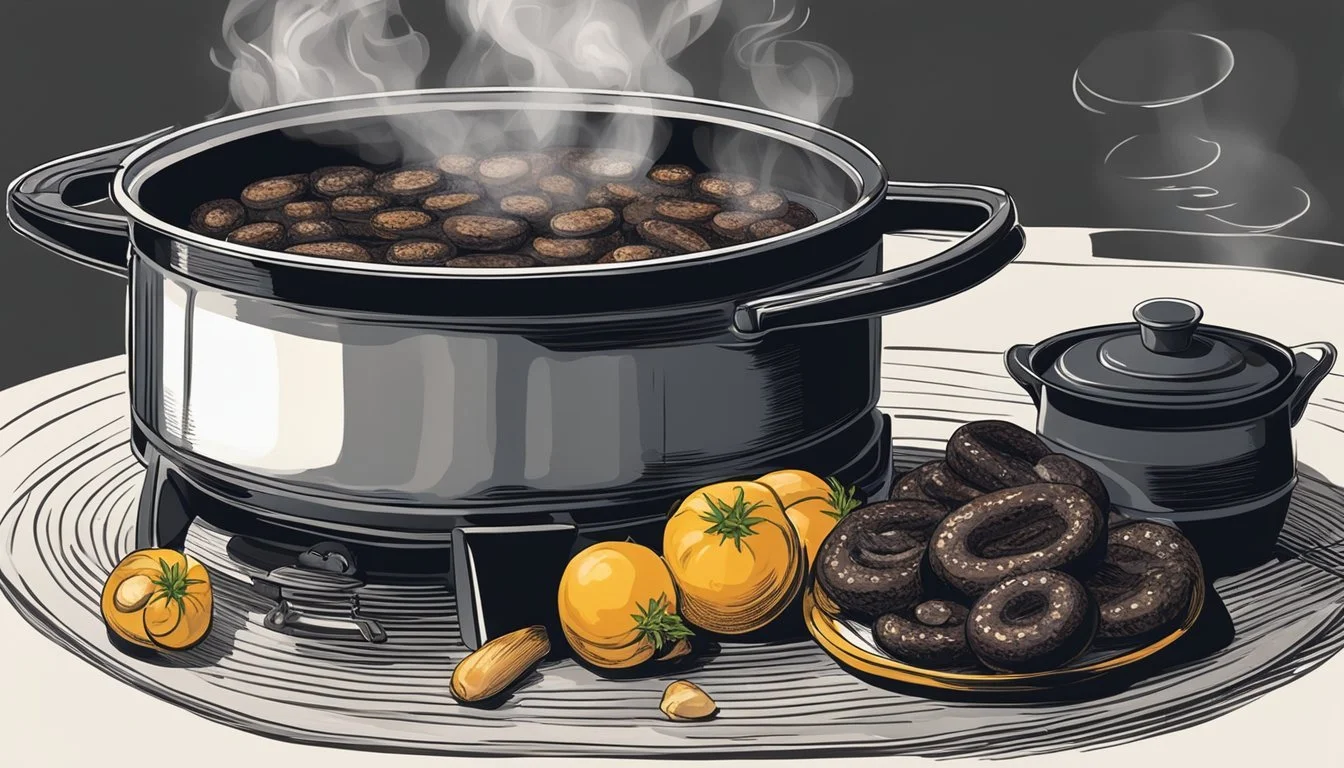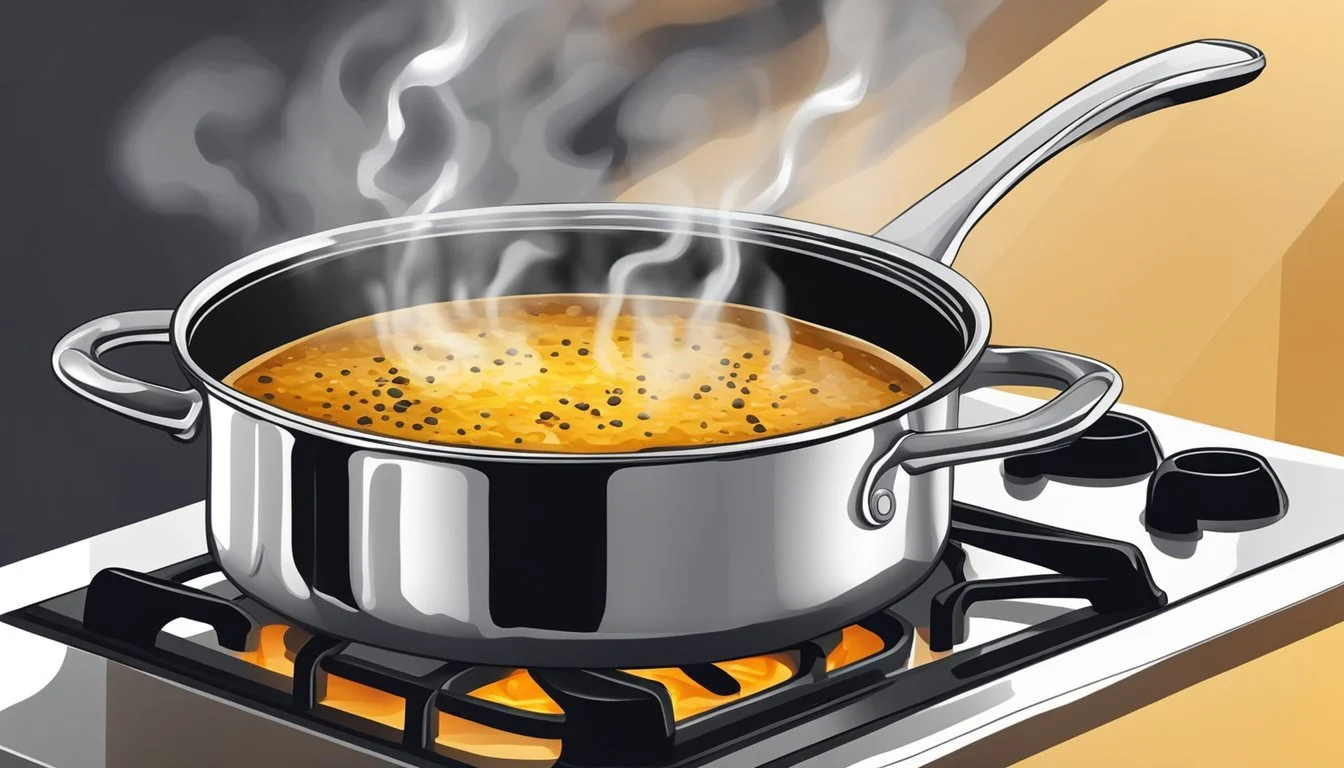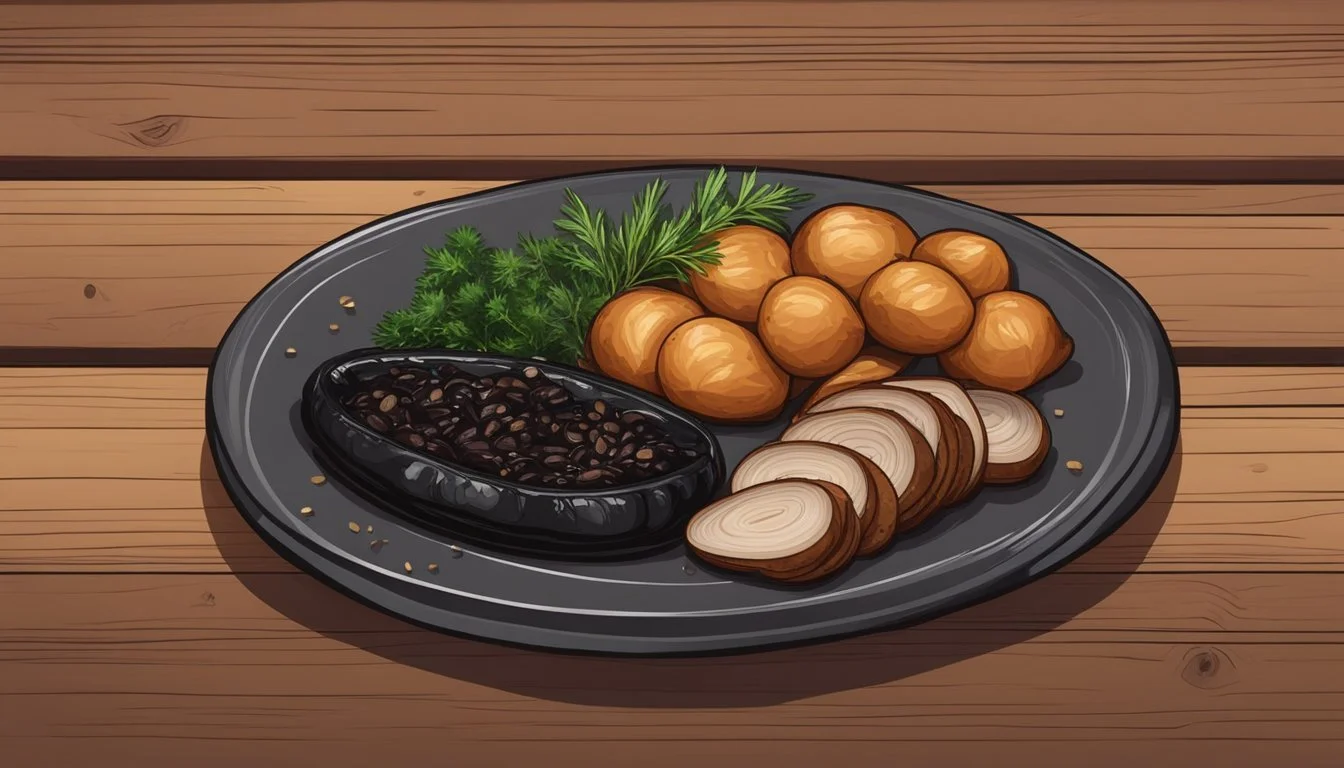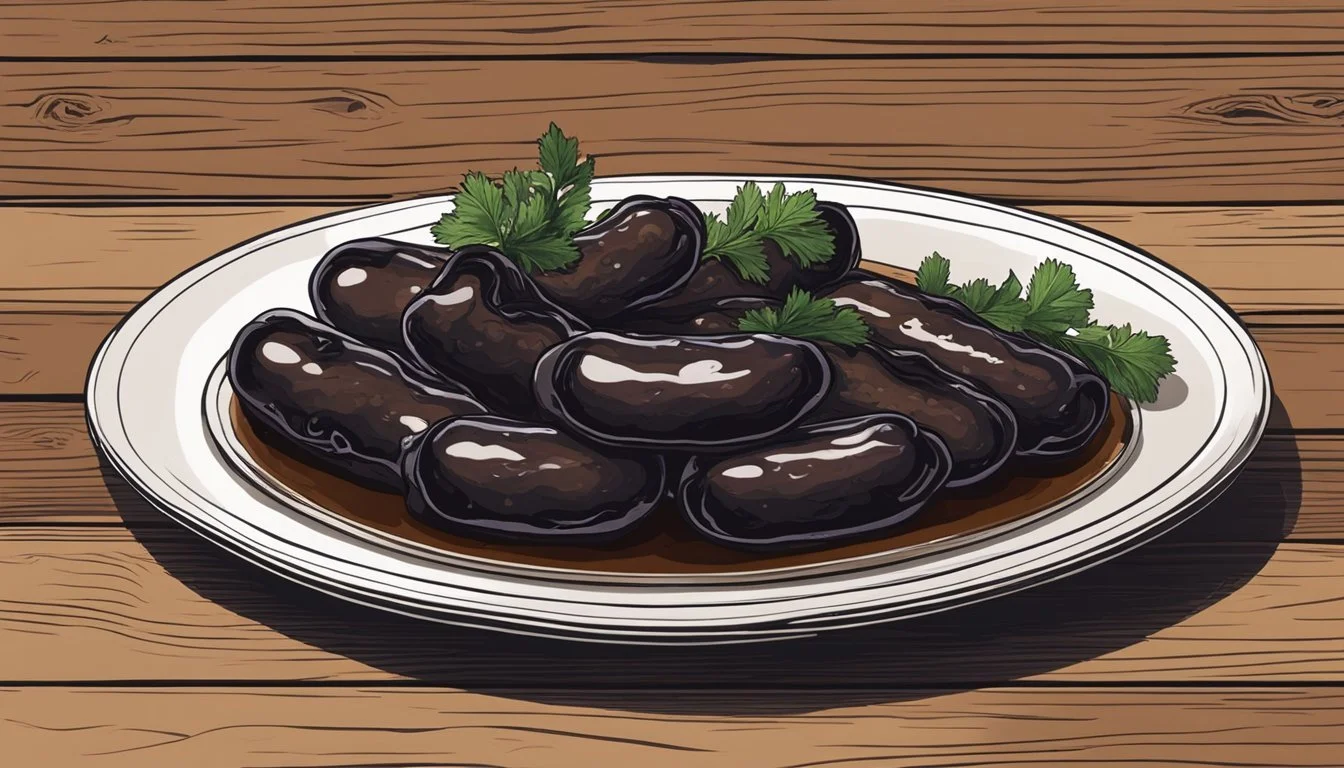Best Way to Reheat Boudin Noir
Preserving Its Rich Taste and Texture
Boudin Noir, a rich and savory sausage with deep roots in French cuisine, has a complexity that requires careful handling, particularly when reheating to preserve its full-bodied flavor and moist texture. Unlike other sausages, Boudin Noir includes blood as a key ingredient, adding to its distinctive taste and texture. It is enjoyed by connoisseurs around the world who appreciate its unique combination of savory meat, blood, fat, and, in some variations, fillers such as rice, onions, and spices. Reheating this delicacy is not just a matter of convenience but an art in itself, demanding techniques that maintain its essence without compromising its integrity.
Two preferred methods for reheating stand out to ensure Boudin Noir’s qualities remain intact. The oven method, heralded for its even heat distribution, involves wrapping the sausage in foil and baking at a low temperature to heat through without drying it out. Gently warming in water is another method that preserves texture while bringing the sausage back to a suitable temperature. Carefully controlled heat allows for a gentle warmth to penetrate the Boudin Noir, rejuvenating its flavors while keeping it tender and juicy. The key in both methods is a balance between adequate heat to warm and a delicate touch to safeguard the sausage's complex flavor profile.
When reheating Boudin Noir, it is crucial to monitor the process actively. Unwavering attention ensures that the sausage is heated sufficiently while avoiding overcooking, which can diminish its nuanced flavors and spoil its tender texture. A culinary thermometer can be used to check for a safe internal temperature without repeatedly opening the oven or unwrapping the foil, which would allow precious moisture to escape. With a little patience and precision, Boudin Noir can be brought back to life, offering a taste that is as close to its original freshly cooked state as possible.
Understanding Boudin Noir
Boudin noir, a type of blood sausage, is a staple in French cuisine and has been adopted with regional variations in places like Louisiana, where Cajun influences play a role. Traditionally, boudin noir is not to be confused with the white boudin found in Cajun cuisine, which contains rice. Rather, it's a rich, dark sausage made from pork, pork blood, and a blend of seasonings and spices.
French boudin noir often omits rice, contrasting with the rice-infused Louisiana variety. Ingredients typically include:
Pork: For richness and texture
Pork blood: Providing the distinct color and flavor
Seasonings and spices: A combination tailored to cultural preferences
The flavor profile of boudin noir is deep and earthy, accented by the particular blend of spices used, which may include cloves, nutmeg, or cinnamon. The characteristic seasoning mix infuses the sausage with layers of taste complexity, making it a beloved delicacy in its native regions.
Cooked and enjoyed as part of a hearty meal, boudin noir is celebrated for its complexity and the way it complements other ingredients on the plate. Care and attention are required when reheating to maintain the integrity of its flavors.
Louisiana's adaptation may integrate ingredients like:
Rice: For a filler that absorbs flavors
Cajun seasoning: Giving it a Southern U.S. twist
Understanding the proper ways to handle and reheat boudin noir is essential for anyone looking to savor its nuanced flavors as intended.
Types and Variations of Boudin
Boudin is a versatile sausage prominent in various culinary traditions, notable for its savory filling sealed in sausage casings. In Cajun cuisine, Cajun boudin stands out, embodying the rich flavors of Louisiana. Traditionally made with pork, rice, onions, green peppers, and a blend of spices, this regional specialty is a testament to Cajun ingenuity.
Boudin Blanc, with French origins, is a milder sausage containing pork without the blood found in Boudin Noir. It often includes milk, breadcrumbs, and is seasoned to accentuate the fine flavors of its ingredients.
The mainstay of boudin sausage is its filling – a well-seasoned mixture that can be adapted based on local tastes and traditions. While Louisiana boudin includes rice and green peppers, variations elsewhere might omit these ingredients in favor of others, reflecting the region's culinary practice.
In Louisiana, seafood sometimes replaces pork, creating a maritime twist on the classic. This variation aligns with coastal traditions and available ingredients like crawfish and shrimp.
Boudin's adaptability is evident in formats beyond links; boudin balls are a festive representation, where the filling is rolled into spheres, breaded, and then deep-fried to achieve a textural contrast between the crispy outside and the tender interior.
In summary, boudin's diversity is celebrated in its many forms, from cajun to coastal and from sausages to balls, each embodying the essence of the region from which they hail. Whether experienced in Louisiana or as part of French cuisine, boudin remains a culinary experience rich in variety and flavor.
Preparation Before Reheating
Before reheating Boudin Noir, one must ensure the sausage is well-prepped to preserve its rich flavor and texture. Correct thawing, handling, and cookware selection are crucial steps.
Thawing Frozen Boudin
Frozen Boudin Noir should be thawed slowly and safely, to maintain its texture and taste. Transfer the frozen boudin from the freezer to the refrigerator 24 hours before reheating. This gradual thawing process prevents the casings from splitting when heated and preserves the integrity of the stuffing.
Handling and Slicing
Once thawed, handle the Boudin Noir with care to avoid damaging the casings. If slicing is desired, use a sharp knife to make half-inch thick pieces. Slicing the boudin before reheating allows heat to permeate more evenly, which can be particularly effective when pan-frying or baking.
Selecting the Right Cookware
Choosing suitable cookware is essential for reheating Boudin Noir. Oven-based reheating should be done on a baking sheet lined with aluminum foil to facilitate an even heat distribution and easy cleanup. Avoid using a microwave as it can unevenly heat Boudin Noir and affect its texture. Instead, opt for gentle cooking methods that more evenly raise the internal temperature, such as baking or simmering in water.
Reheating Boudin Noir in the Oven
When reheating Boudin Noir in the oven, attention to temperature and timing is crucial to preserve the sausage's unique flavors and succulent texture without drying it out.
Oven Method for Whole Links
To reheat whole links of Boudin Noir:
Preheat the oven to 300°F to ensure even heating.
Place the whole Boudin Noir links on a baking sheet. For easier cleanup, one may line the baking sheet with aluminum foil or parchment paper.
Heat the links for 20-25 minutes if they're thawed, and longer if they're frozen. This lower temperature aids in reheating without compromising the Boudin Noir's moisture.
Check halfway through to ensure they are heating evenly and not bursting the casings.
Baking Sliced Boudin
For sliced Boudin Noir:
Cut the Boudin Noir into half-inch thick slices.
Arrange the slices on a baking sheet lined with aluminum foil or parchment paper, spaced apart evenly.
Bake in the preheated oven at 300°F until the slices become golden brown, about 10-15 minutes.
If reheating from frozen, increase the time slightly, monitoring to prevent overcooking the stuffing.
One must always avoid overheating to maintain the Boudin Noir's complex flavor and texture.
Stovetop Techniques for Boudin Noir
When reheating boudin noir on the stovetop, it's essential to preserve its rich flavors and moist interior. Two effective methods are pan-frying and boiling, each offering a distinct texture and finish to the sausage.
Pan-Frying Boudin
To pan-fry boudin noir, one begins by heating a moderate amount of oil or butter in a pan over a medium flame. This introduces a desirable crispness to the skin. An ideal choice is a non-stick or cast-iron pan, which helps ensure an even cook. The boudin should be turned occasionally with tongs to foster a uniform exterior without rupturing the skins. The entire process typically takes around 5-10 minutes, depending on the starting temperature of the sausage.
Oil/Fat: A small amount (about 1-2 tablespoons)
Pan: Preferably non-stick or cast-iron
Heat: Medium
Duration: 5-10 minutes
Technique:
Add oil or butter to pan, heat until hot but not smoking.
Place boudin in pan, using tongs to turn occasionally.
Cook until skin is evenly crisped to preference.
Boiling Boudin Noir
Boiling is a gentler way to reheat boudin noir, keeping sausage skins intact and the contents moist. One should start by placing the sausage in a pot and cover it with cold water. Then slowly bring the water to a low simmer—never a full boil, as high temperatures can cause the skins to burst. Once simmering, the heat should be reduced, and the sausage allowed to warm through for about 10-15 minutes.
Boiling Water: Enough to cover the sausage
Heat: Bring to a low simmer, then reduce
Duration: 10-15 minutes
Technique:
Place boudin in cold water, then heat to a simmer.
Reduce heat to low, ensuring water is not boiling.
Use tongs to remove boudin after it's thoroughly heated.
The stovetop ensures a quick and focused heating method, allowing better control over the temperature and preventing drying out or overcooking the boudin noir. Whether one chooses to pan-fry for a crispy skin or boil for a tender bite, both methods effectively reheat the boudin while maintaining its complex flavor profile.
Alternative Reheating Methods
When reheating boudin noir, it's crucial to preserve its flavor and texture. Here are some alternative methods beyond traditional oven warming, each suitable for specific circumstances or personal preferences.
Using the Microwave
To use the microwave, one should place the boudin noir on a microwave-safe dish and cover it with a damp paper towel to keep it moist. It is recommended to heat on medium power in 30-second intervals, checking regularly to avoid overheating, as the microwave may cause the fat in the boudin to render unevenly and affect the texture.
Grilling Boudin Noir
Grilling offers a way to reheat boudin noir while adding a smoky flavor. Gently heat the grill to a moderate temperature and lightly brush the boudin with oil to prevent sticking. Wrap the boudin in aluminum foil or place it directly on the grill, turning frequently for an even reheat. The goal is to warm through without charring the casing or causing the boudin noir to burst.
Air Fryer Instructions
An air fryer provides a quick and effective method for reheating boudin balls. Preheat the air fryer to 350°F, place the boudin balls in the basket, and heat for about 4-5 minutes. Ensure there's space between them for even air circulation. The resulting boudin balls should have a crispy exterior while retaining moistness inside. It's important not to overcrowd the basket to prevent uneven reheating.
Accompaniments and Side Dishes
When serving boudin noir, the choice of side dishes can greatly enhance the dining experience. Cajun cuisine offers a variety of options that pair well with the rich flavors of boudin. Below is a curated list of side dishes that complement boudin noir.
Starchy Sides:
Cornbread: A classic Cajun companion, cornbread brings a sweet and savory balance to the meal.
White Rice: A simple bed of white rice allows the bold flavors of boudin noir to shine through.
Potato Salad: Creamy potato salad provides a cooling contrast to the spiciness of Cajun dishes.
Vegetable Accompaniments:
Sautéed Bell Peppers: A mixture of colorful bell peppers sautéed until just tender.
Roasted Vegetables: (What wine goes well with roasted vegetables?) An assortment of roasted vegetables like carrots and zucchini can add a healthy and flavorful side.
Cajun Classics:
Gumbo: Though typically a main dish, a small serving of gumbo with shrimp can act as a rich and hearty accompaniment.
Jambalaya: With rice, meats, and seafood, jambalaya complements boudin without overpowering it.
Sauces and Condiments:
Mustard: A tangy mustard sauce makes for a simple yet effective pairing with boudin noir.
Cajun Remoulade: This spiced mayonnaise-based sauce adds a layer of complexity to the dish.
Breads:
French Bread: Slices of crusty French bread serve as a vessel for those who enjoy boudin spread across bread.
When selecting sides, it's important to consider the balance of flavors and textures to ensure that the accompaniments don't overshadow the distinctive taste of boudin noir. These recommended sides are designed to complement, rather than compete with, the deep and savory flavors of boudin noir.
Serving Suggestions and Presentation
When showcasing Boudin Noir as a culinary treat, presentation is paramount. Ideally, it's served warm—neither too hot nor cold—to best enjoy its complex flavors. Whether it's featured as a main dish or an appetizer, there are several ways to enhance the dining experience.
For a family dinner, Boudin Noir can be presented as a main dish. Placed at the center of the plate, the sliced sausage should be surrounded by a selection of vegetables—roasted root vegetables are a great choice for their earthy flavor, which complements the Boudin Noir.
French cuisine often pairs Boudin Noir with caramelized apples, offering a sweet counterpoint to the rich and savory sausage.
Meal Suggestion Breakfast Serve with scrambled eggs and crusty bread. Appetizer Slice thinly, pair with a light salad. Dinner Accompany with mashed potatoes, and a red wine.
Cajun variations may include a side of dirty rice or stewed greens, embracing the heritage of Cajun cuisine. When served as an appetizer, thin slices on small toasts work well, maybe with a sprinkle of garnishes like chives or parsley for color and freshness.
The inclusion of bread is traditional, providing a textural balance. For those looking to stay authentic, a crusty baguette or warm brioche can serve as a vehicle for the Boudin Noir, enhancing its flavors.
For a weekday breakfast, it can be sliced and lightly seared on both sides, and served alongside eggs, emphasizing the sausage as a protein-rich start to the day. Regardless of how it is incorporated into a meal, Boudin Noir requires thoughtful plating to honor its rich flavor and heritage.
Food Safety Tips for Reheated Boudin Noir
When handling leftover boudin noir, popularly known as blood sausage, one should prioritize food safety to ensure that the reheating process does not compromise either the complex flavor or the safety of the dish.
Safe Storage: Leftover boudin noir must be stored in the refrigerator at 40°F (4°C) or below and consumed within 2-3 days. It should be kept in an airtight container to prevent contamination and to keep it from absorbing other flavors.
Reheating Temperature: To guarantee the safety of the reheated boudin noir, one must reheat it to an internal temperature of 165°F (74°C). Use a food thermometer to check the temperature at the center of the sausage.
Methods of Reheating:
Saucepan: Gently heat the boudin noir in a saucepan over low-to-medium heat. Add a small amount of water or broth to keep it moist.
Oven: Preheat the oven to 325°F (163°C), place the boudin noir on a baking sheet, and cover it with foil. Reheat until it reaches the required internal temperature.
Method Tool Temperature Saucepan Food Thermometer 165°F (74°C) Oven Oven, Foil, Baking Sheet 165°F (74°C)
Avoid repeated warming cycles, as they risk promoting bacterial growth and can degrade the texture and flavor of the boudin noir. Furthermore, do not leave the sausage at room temperature for over two hours before refrigeration or reheating.
Cross-Contamination: Always use clean utensils and surfaces when handling boudin noir to prevent cross-contamination from raw foods or other sources.
By adhering to these food safety tips, the reheating of boudin noir can be done confidently, keeping the dish delicious and safe for consumption.
Maximizing Flavor and Texture
When reheating Boudin Noir, retaining its distinctive flavor and texture is paramount. Boudin Noir is a richly seasoned sausage, where the harmony of spices, herbs, and meat is essential. The key to preserving its complexity lies in gentle reheating methods that maintain the integrity of its ingredients.
One must handle the delicate stuffing, filled with onions, pork meat, and unique spice blends, with care. Employing a method that evenly warms without causing the sausage casings to rupture ensures that the well-balanced stuffing retains its intended savoriness.
Oven Method:
Temperature: Preheat to 300°F
Duration: 20-25 minutes
Preparation: Wrapping each piece of Boudin Noir in aluminum foil can lock in moisture and flavor.
Boiling Method:
Water Temperature: Gentle simmer
Duration: 10-15 minutes
Preparation: Place Boudin Noir in the water, ensuring it does not boil vigorously to prevent splitting the casing.
Recommended Internal Temperatures:
Thermometer Check: Aim for 160°F for thorough heating
By following these careful steps, the Boudin Noir reemerges with a tender texture and a hearty, flavorful profile that's sure to please the palate. Whether through oven warming or a gentle simmer, the ultimate goal is a moist, flavorful, and well-textured Boudin Noir without any compromise to its original quality.
Nutritional Information and Health Benefits
Boudin Noir is a variety of French blood sausage rich in several key nutrients beneficial for health. It is especially known for being a good source of protein, providing the basic building blocks required for muscle maintenance and repair. When eaten in moderation, it can be a part of a balanced diet.
The sausage includes pork meat, liver, and blood, which contribute to its distinctive flavor, as well as its nutritional profile. Boudin Noir is rich in iron due to the blood content, which is crucial in preventing anemia by assisting in the production of red blood cells.
Here is a brief nutritional breakdown:
Protein: Essential for muscle repair and enzymatic activities
Fat: Provides energy; however, consumption should be monitored
Carbohydrates: Often low in blood sausage, but provides energy
Iron: Supports blood health and oxygen transport
It’s pertinent to note that like many products made from pork, Boudin Noir can contain higher levels of fat, so it's advisable to consume it judiciously.
The liver in the sausage is a source of various minerals and vitamins, including Vitamin B12, which is involved in nerve function and the production of DNA. These nutrients can have positive implications for long-term health, such as the maintenance of the central nervous system.
Consumers should be aware of the rich and dense nature of Boudin Noir and include it in a diet that balances its nutritional benefits with an awareness of its high caloric density.
Storing Leftover Boudin Noir
When handling leftover boudin noir, proper storage is critical to preserve its flavor and ensure food safety. Boudin noir should be refrigerated or frozen as soon as it has cooled down to minimize the risk of bacterial growth.
Refrigeration:
Place the boudin noir in an airtight container.
Boudin noir can be kept in the refrigerator for up to 3 days.
Freezing:
For longer storage, boudin noir can be frozen.
Use airtight freezer bags or vacuum-sealed containers to prevent freezer burn.
Clearly label the bags or containers with the date of storage.
Thawing Frozen Boudin Noir:
Thaw in the refrigerator overnight.
Avoid thawing at room temperature to reduce the risk of bacteria.
storage guidelines for frozen boudin noir:
Method Duration Notes Refrigeration Up to 3 days Store in airtight container Freezer Up to 3 months Use airtight freezer bags or vacuum-sealed containers Thawing Overnight in fridge Do not thaw at room temperature
It's important to maintain the boudin noir's quality during storage. A properly stored boudin noir will retain its complex flavors and provide an enjoyable experience upon reheating.
Creative Ways to Reuse Leftover Boudin Noir
Leftover boudin noir can be a delightful ingredient to play with in the kitchen, offering robust flavors to various dishes. Repurposing leftovers is both economic and innovative, making sure nothing goes to waste.
Transform into Stuffing: One can easily incorporate chopped boudin noir into the stuffing for bell peppers or mushrooms. The rich taste of the boudin enhances the natural flavors of the vegetables, providing a sumptuous side dish or main course.
Incorporate into Gumbo: Leftover boudin noir is perfect for adding depth to a classic gumbo. Dice the boudin and add it in the last 30 minutes of cooking to maintain its texture and taste, enriching the gumbo with its distinct spices.
Boudin Noir Jambalaya: Boudin noir can replace traditional proteins in jambalaya. Its robust flavor pairs well with the Creole seasonings and rice, making it a hearty and flavorful one-pot meal.
Fried Boudin Balls: Create bite-sized pleasures by shaping leftover boudin into balls, rolling them in breadcrumbs, and frying until golden. These can serve as a satisfying appetizer or a snack.
Recipe Instructions Boudin Balls 1. Form into balls
2. Coat in breadcrumbs
3. Fry until golden Stuffed Peppers 1. Hollow out peppers
2. Stuff with chopped boudin
3. Bake until tender Gumbo Addition 1. Prepare gumbo as usual
2. Add diced boudin noir
3. Simmer and serve
By following these suggestions, leftover boudin noir can be repurposed into new, appetizing creations that please the palate and minimize food waste.










